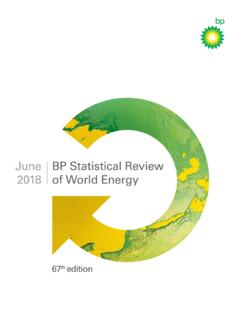Transcription of Full report – BP Statistical Review of World Energy 2018
1 67th editionMethodological changesThis year s Statistical Review introduces two changes in how oil and gas are reported in Energy units. First, primary consumption of Energy from oil is now reported in tonnes of oil equivalent where one tonne of oil is defined as 10 Gcal (gigacalories) or GJ (gigajoules). Second, the tables now report natural gas volumes in terms of a standardized gas at a temperature of 15 C and a pressure of 1013 mbar with a gross calorific value of 40 MJ (megajoules) per cubic more onlineAll the tables and charts found in the printed edition are available at plus a number of extras, including: The Energy charting tool view predetermined reports or chart specific data according to Energy type, region, country and year. Historical data from 1965 for many sections. Additional country and regional coverage for all consumption tables. Additional data for refined oil production demand, natural gas, coal, hydroelectricity, nuclear Energy and renewables.
2 PDF versions and PowerPoint slide packs of the charts, maps and graphs, plus an Excel workbook and database format of the data. Regional and country factsheets. Videos and the BP World Energy appExplore the World of Energy from your tablet or smartphone. Customize charts and perform the calculations. Review the data online and offline. Download the app for free from the Apple App Store and Google play store. Introduction1 Group chief executive s introduction2 2017 at a glance3 Group chief economist s analysis Primary energy8 Consumption 9 Consumption by fuel Oil12 Reserves14 Production and consumption20 Prices22 Refining24 Trade movements Natural gas26 Reserves28 Production and consumption33 Prices34 Trade movements Coal36 Reserves and prices 38 Production and consumption Nuclear energy41 Consumption Hydroelectricity42 Consumption Renewable energy44 Other renewables consumption45 Biofuels production Electricity46 Generation 48 Generation by fuelCO2 Carbon49 Carbon dioxide emissions Key materials50 Production 51 Reserves 51 Prices Appendices52 Approximate conversion factors52 Definitions53 More informationFor 66 years, the BP Statistical Review of World Energy has provided high-quality objective and globally consistent data on World Energy markets.
3 The Review is one of the most widely respected and authoritative publications in the field of Energy economics, used for reference by the media, academia, World governments and Energy companies. A new edition is published every more onlineAll the tables and charts found in the latest printed edition are available at plus a number of extras, including: The Energy charting tool view predetermined reports or chart specific data according to Energy type, region, country and year. Historical data from 1965 for many sections. Additional data for refined oil production demand, natural gas, coal, hydroelectricity, nuclear Energy and renewables. PDF versions and PowerPoint slide packs of the charts, maps and graphs, plus an Excel workbook of the data. Regional and country factsheets. Videos and OutlookWatch the BP Energy Outlook 2017 video, containing our projections of long-term Energy trends to 2035.
4 Download the booklet and presentation materials at the conversation#BPstatsDownload the BP World Energy appExplore the World of Energy from your tablet or smartphone. Customize charts and perform the calculations. Review the data online and offline. Download the app for free from the Apple App Store and Google play data series for proved oil and gas reserves in BP Statistical Review of World Energy June 2017 does not necessarily meet the definitions, guidelines and practices used for determining proved reserves at company level, for instance, as published by the US Securities and Exchange Commission, nor does it necessarily represent BP s view of proved reserves by country. Rather, the data series has been compiled using a combination of primary official sources and third-party Statistical Review of World Energy 20181 Group chief executive s introductionAs well as highlighting these longer-term trends, this year s Statistical Review also shines a light on the shorter-term developments affecting our industry.
5 In the oil market, yet another year of robust demand growth, combined with the production cuts of OPEC and other participating countries, allowed oil inventories to fall back towards more normal levels. But the rapid growth of US tight oil over the same period should caution us that the recent firming in oil prices is unlikely to persist. In BP, we remain firmly focused on efficiency, reliability and capital discipline. In natural gas markets, another year of strong expansion of global LNG supplies helped to improve the accessibility of gas around the globe, with clear signs that the major regional gas markets are becoming increasingly integrated. This greater accessibility and integration should help to underpin the long-term use of natural gas. Our industry operates and makes decisions at many different frequencies. Day-to-day, year-to-year, we need to understand how the markets in which we operate are changing and developing as new sources of supply emerge and demand evolves.
6 Over the longer-term, we need to gauge the forces shaping the Energy transition and ensure that we play our part in meeting the dual challenge of supplying the Energy the World needs to grow and prosper, while also reducing carbon emissions. These judgements and decisions require timely and reliable data. This is the role that the Statistical Review has been playing for the past 67 years. I know that in BP we find the data and analysis invaluable for our own decision making. I hope you find it a useful resource for your own work. Let me conclude by thanking BP s economics team and all those who helped us prepare this Review in particular those in the governments around the World who contributed their official data again this year. Thank you for your continuing cooperation and DudleyGroup chief executiveJune 2018 Prior to 2017, there had been three successive years of little or no growth in carbon emissions from Energy consumption.
7 This came about through accelerating gains in Energy efficiency muting growth in Energy demand, and rapid growth in renewable Energy combined with successive falls in global coal consumption leading to improvements in the fuel progress partially reversed last year. Growth in Energy demand picked up as gains in Energy efficiency slowed, coal consumption increased for the first time in four years, and carbon emissions from Energy consumption reversal should not come as a complete surprise. As we highlighted at the time, in addition to benefitting from longer-term structural forces, some of the exceptional performance seen in recent years had been boosted by temporary, cyclical developments, particularly in China, and so some reversal was always likely. Those longer-term forces shaping the transition continued last year. Renewable Energy grew strongly again, with particularly striking gains in solar capacity and generation.
8 Natural gas was the largest source of Energy growth, boosted by a massive programme of coal-to-gas switching in industrial and residential sectors in much more progress is needed. In particular, data included in this year s Review for the first time highlight the need for greater advances in the power sector. The power sector really matters. It absorbs more primary Energy than any other sector. It accounts for over a third of carbon emissions from Energy consumption. However, despite the huge policy push encouraging a switch away from coal and the rapid expansion of renewable Energy in recent years, there has been no improvement in the mix of fuels feeding the global power sector over the past 20 years. Astonishingly, the share of coal in 2017 was exactly the same as in 1998. The share of non-fossil fuels was actually lower, as growth in renewables has failed to compensate for the decline in nuclear Energy .
9 The failure to make any inroads into the power sector since the turn of the century should be both a cause for concern and a focus for future to BP s Statistical Review of World Energy which records the events of 2017, a year in which global Energy markets took a partial step back from the exceptional momentum of recent years towards a lower carbon Energy Statistical Review of World Energy 201822017 at a glanceGlobal primary Energy consumption grew strongly in 2017, led by natural gas and renewables, with coal s share of the Energy mix continuing to developments Primary Energy consumption growth averaged in 2017, up from last year and the fastest since 2013. This compares with the 10-year average of per year. By fuel, natural gas accounted for the largest increment in Energy consumption, followed by renewables and then oil. Energy consumption rose by in China. China was the largest growth market for Energy for the 17th consecutive emissions Carbon emissions from Energy consumption increased by , after little or no growth for the three years from 2014 to 2016.
10 Oil The oil price (Dated Brent) averaged $ per barrel, up from $ in 2016. This was the first annual increase since 2012. Global oil consumption growth averaged , or million barrels per day (b/d), above its 10-year average of for the third consecutive year. China (500,000 b/d) and the US (190,000 b/d) were the single largest contributors to growth. Global oil production rose by million b/d, below average for the second consecutive year. US (690,000 b/d) and Libya (440,000 b/d) posted the largest increases in output, while Saudi Arabia (-450,000 b/d) and Venezuela (-280,000 b/d) saw the largest declines. Refinery throughput rose by an above-average million b/d, while refining capacity growth was only million b/d, below average for the third consecutive year. As a result, refinery utilization climbed to its highest level in nine gas Natural gas consumption rose by 96 billion cubic metres (bcm), or 3%, the fastest since 2010.
















